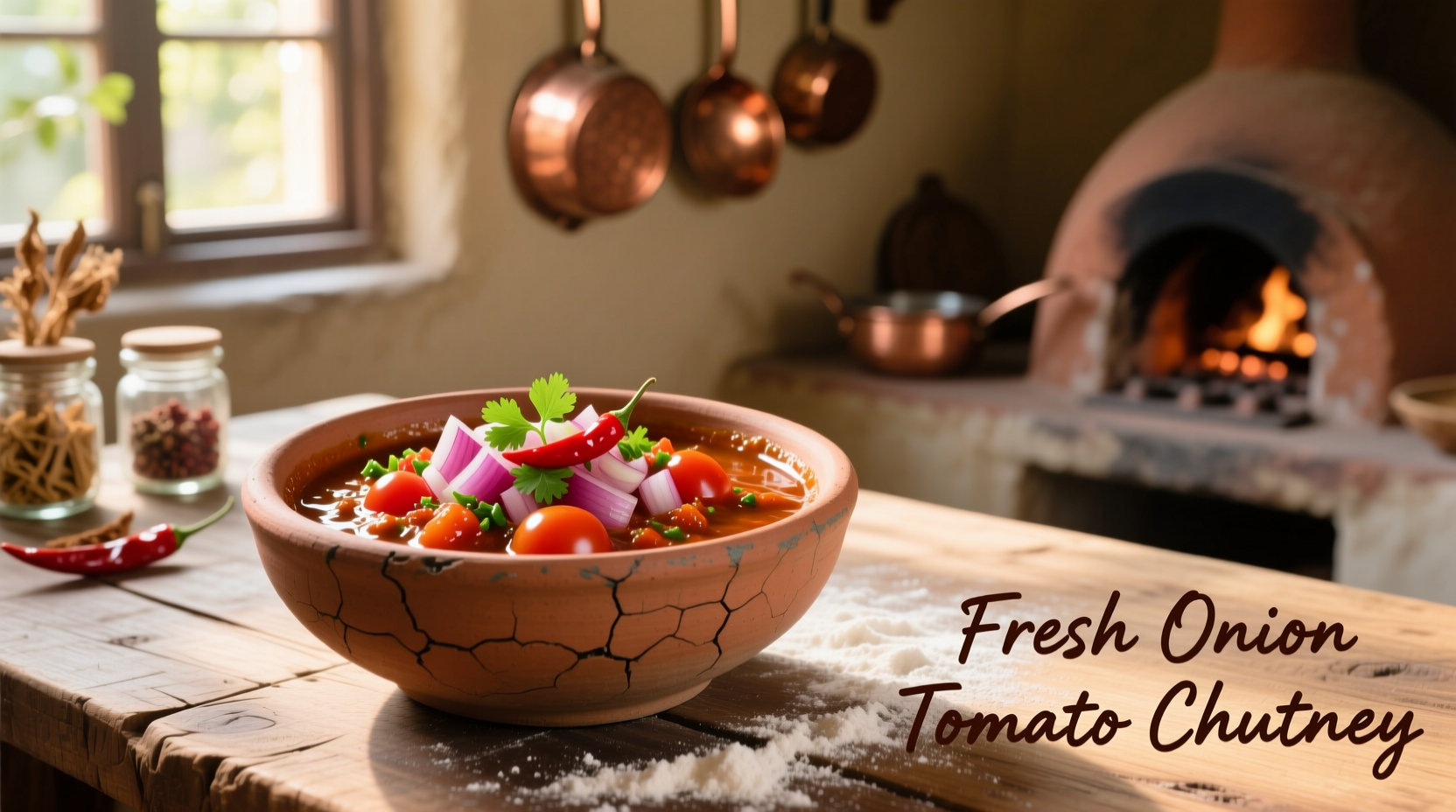Onion tomato chutney delivers a vibrant balance of sweet, tangy, and spicy flavors that elevates everyday meals. This authentic Indian condiment requires just 6 basic ingredients, takes 20 minutes to prepare, and stays fresh for 2 weeks refrigerated. Master the perfect texture and flavor balance with our step-by-step guide featuring regional variations from Mumbai street food stalls to South Indian kitchens.
Nothing transforms a simple meal like a spoonful of freshly made onion tomato chutney. This versatile Indian condiment bridges the gap between salsa and relish, offering complex layers of flavor that complement everything from dosas to grilled meats. Unlike store-bought versions loaded with preservatives, homemade chutney lets you control the spice level and freshness while capturing authentic regional tastes.
What Makes Onion Tomato Chutney Special
Originating in Indian street food culture, this chutney combines two humble ingredients into something extraordinary. The magic happens through careful balancing of raw onion's sharpness with tomato's natural sweetness, enhanced by traditional spices. Food historians note its evolution from royal Mughlai kitchens to everyday street food stalls across India, adapting to local tastes while maintaining its essential character.
| Regional Variation | Key Differences | Best Paired With |
|---|---|---|
| Mumbai Street Style | Extra green chilies, lemon juice, minimal spices | Vada pav, bhel puri |
| South Indian Version | Tamarind paste, curry leaves, mustard seeds | Dosas, idlis, rice |
| North Indian Restaurant Style | Roasted cumin, ginger, creamier texture | Parathas, kebabs |
Essential Ingredients Checklist
Quality ingredients make the difference between ordinary and exceptional chutney. For authentic flavor:
- Tomatoes: Use ripe but firm Roma tomatoes (4 medium) for balanced acidity
- Onions: Red onions (1 large) provide the perfect sweet-sharp contrast
- Chilies: 1-2 green chilies (adjust to taste) - Kashmiri chilies offer milder heat
- Tempering spices: Mustard seeds, curry leaves, asafoetida (hing)
- Acid component: Fresh lemon juice (1 tbsp) or tamarind paste
- Finishing touch: Fresh cilantro and a pinch of sugar to balance flavors

Step-by-Step Preparation Guide
Follow these professional techniques for perfect texture and flavor development:
Preparation Phase (5 minutes)
- Wash and roughly chop tomatoes (no need to peel)
- Finely dice red onions - smaller pieces create smoother texture
- Remove seeds from green chilies for milder heat
- Measure all spices before starting - chutney comes together quickly
Cooking Process (15 minutes)
- Heat 2 tbsp oil in cast iron pan until shimmering
- Add 1 tsp mustard seeds - wait until they pop before proceeding
- Add 8-10 curry leaves and pinch of asafoetida for authentic flavor base
- Sauté onions for 3 minutes until translucent but not browned
- Add tomatoes, green chilies, and ¼ tsp turmeric
- Cook uncovered for 8-10 minutes until tomatoes break down completely
- Stir in 1 tbsp lemon juice and ½ tsp sugar during final minute
- Remove from heat and cool slightly before serving
When to Use vs. When to Avoid
Understanding context boundaries ensures perfect results every time:
- Ideal applications: Serve with dosas, idlis, parathas, or as sandwich spread
- Best temperature: Room temperature for maximum flavor release
- Avoid with: Delicate fish dishes where strong flavors would overwhelm
- Texture warning: Overcooking creates mushiness - maintain some tomato structure
- Flavor pairing tip: Balance with cooling raita when serving spicy meals
Storage and Shelf Life Guidelines
Proper storage maintains freshness and safety:
- Cool completely before transferring to airtight container
- Refrigerate for up to 14 days (shorter in humid climates)
- Freeze in ice cube trays for longer storage (3 months)
- Always use clean utensils to prevent contamination
- Discard if mold appears or smell becomes sour
Evolution of Onion Tomato Chutney
This condiment's journey reflects India's culinary adaptation:
- 1800s: British introduction of tomatoes to Indian cuisine
- Early 1900s: Street vendors combine tomatoes with traditional onion chutneys
- 1940s-1960s: Regional variations emerge across Indian states
- 1980s: Commercial production begins with preservatives
- Present: Global popularity drives authentic homemade versions
Troubleshooting Common Issues
Solve these frequent preparation challenges:
- Too watery: Cook uncovered longer or add 1 tsp roasted chana dal powder
- Too spicy: Balance with ½ tsp sugar and extra tomato
- Bland flavor: Increase tempering spices or add ¼ tsp amchur (mango powder)
- Dark color: Avoid overcooking - tomatoes should retain some vibrancy
- Separation: Stir well before serving; indicates proper oil infusion











 浙公网安备
33010002000092号
浙公网安备
33010002000092号 浙B2-20120091-4
浙B2-20120091-4